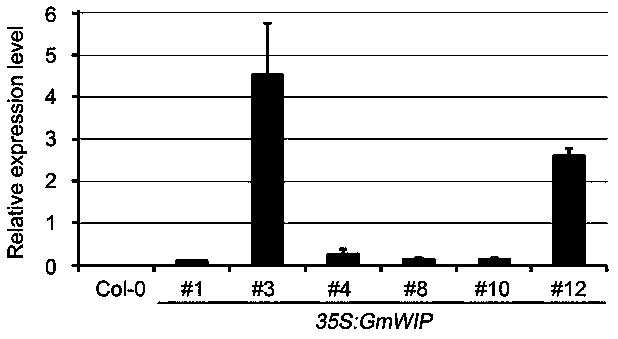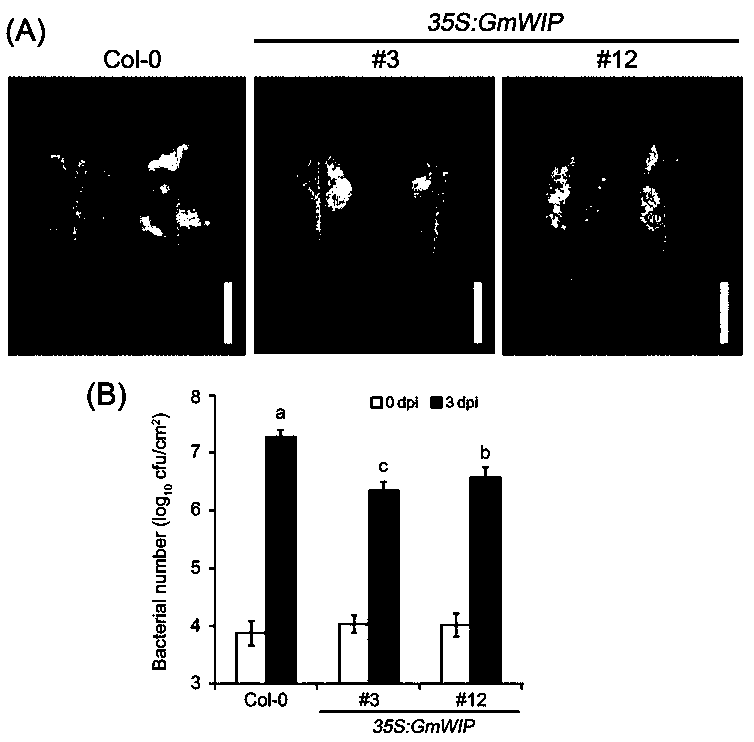Wound-induced gene of soybeans, and coded protein and application thereof
A protein-encoding and gene-encoding technology, applied in applications, genetic engineering, plant genetic improvement, etc., can solve problems such as agricultural production losses, and achieve the effect of increasing plant resistance to bacterial diseases
- Summary
- Abstract
- Description
- Claims
- Application Information
AI Technical Summary
Problems solved by technology
Method used
Image
Examples
Embodiment 1
[0022] Example 1: Cloning GmWIP Gene
[0023] Soybean ( Glycine max ) a gene encoding a wound-inducible protein was highly expressed in the nodule transcriptome GmWIP . Using the soybean nodule cDNA as a template, the polymerase chain reaction (PCR) method was used to clone GmWIP CDS sequence of the gene. The full length of the CDS sequence is 255bp, encoding a protein consisting of 84 amino acid residues. This result correlates with that published by the Soybean Genome Database (https: / / phytozome.jgi.doe.gov / pz / ) GmWIP The relevant sequence information of the genes is completely consistent.
Embodiment 2
[0024] Example 2: Construction GmWIP constitutive expression vector
[0025] First PCR clone with upstream and downstream primers with restriction enzyme sites Xho I and BamH I respectively GmWIP CDS sequence, through a series of enzyme digestion-ligation reactions GmWIP The CDS was ligated into the intermediate vector pA7 to obtain 35S:GmWIP - pA7 intermediate vector. Then use Hind III and EcoR I double digestion reaction to 35S:GmWIP The fragment was excised and connected to the binary vector pCAMBIA2301 to obtain the final 35S:GmWIP - pCAMBIA2301 vector.
Embodiment 3
[0026] Embodiment three: GmWIP Transformation of Arabidopsis thaliana with constitutive expression vector
[0027] Complete the above construction 35S:GmWIP -The pCAMBIA2301 vector was transformed into Agrobacterium strain GV3101 by heat shock method, and then the target gene was transformed into Arabidopsis thaliana through flower dipping method through Agrobacterium infection. The transgenic positive plants were obtained by kanamycin plate screening, and then T3 generation homozygous transgenic plants were obtained after two generations of self-propagation.
PUM
 Login to View More
Login to View More Abstract
Description
Claims
Application Information
 Login to View More
Login to View More - R&D
- Intellectual Property
- Life Sciences
- Materials
- Tech Scout
- Unparalleled Data Quality
- Higher Quality Content
- 60% Fewer Hallucinations
Browse by: Latest US Patents, China's latest patents, Technical Efficacy Thesaurus, Application Domain, Technology Topic, Popular Technical Reports.
© 2025 PatSnap. All rights reserved.Legal|Privacy policy|Modern Slavery Act Transparency Statement|Sitemap|About US| Contact US: help@patsnap.com



